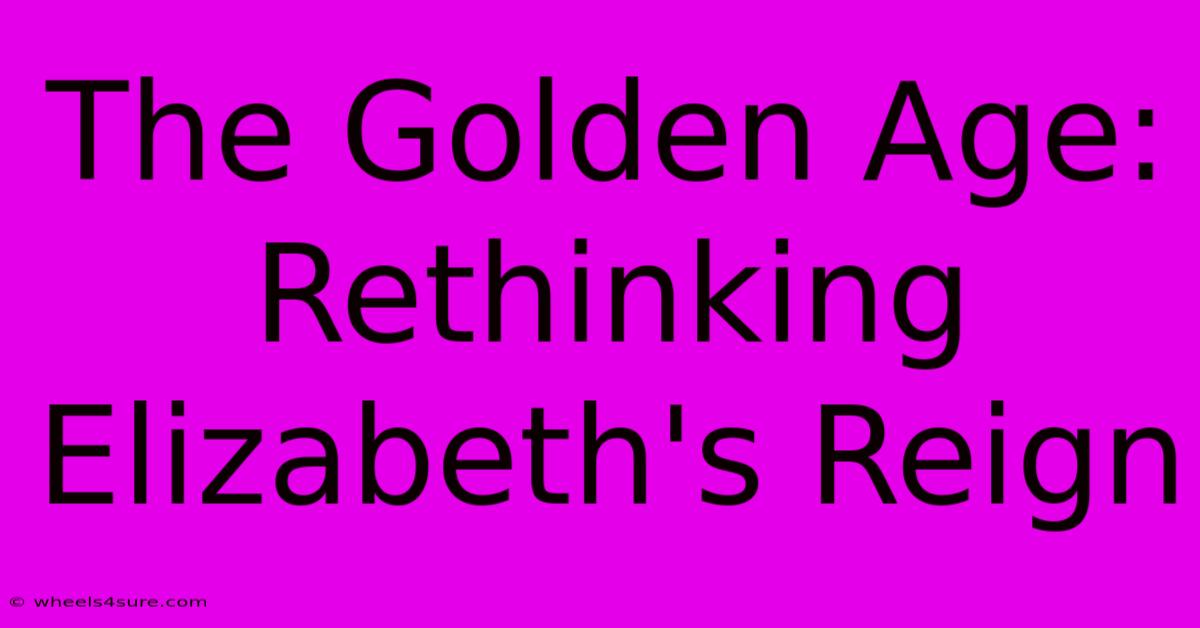The Golden Age: Rethinking Elizabeth's Reign

Table of Contents
The Golden Age? Rethinking Elizabeth I's Reign
The reign of Elizabeth I (1558-1603) is often portrayed as a "Golden Age," a period of unparalleled prosperity, cultural flourishing, and national strength. Shakespeare's plays, the defeat of the Spanish Armada, and the establishment of a relatively stable Protestant England all contribute to this romanticized image. But a closer look reveals a more complex and nuanced reality, challenging the simplistic narrative of a golden age and prompting a necessary rethinking of Elizabeth's legacy.
Beyond the Glitter: Economic Realities of Elizabethan England
While the Elizabethan era witnessed some economic growth, it's crucial to acknowledge the significant inequalities that persisted. Mercantilism, the dominant economic policy, fueled the expansion of English trade, particularly with the New World. However, this expansion benefited a relatively small elite, leaving many impoverished and facing food shortages and landlessness. The enclosure movement, which saw common lands privatized, displaced many peasants and exacerbated existing social tensions. The "golden age" wasn't golden for everyone.
The Price of Prosperity: Social Inequality and Poverty
The glittering court of Elizabeth I masked stark realities for the majority of the population. Poverty remained widespread, with begging and vagrancy prevalent. Harsh laws were enacted against the poor, reflecting the anxieties of the ruling class. While England experienced a period of relative peace and stability compared to continental Europe, life for many remained a struggle for survival, far removed from the opulent image often associated with the Elizabethan era.
Religious Tensions and the Shadow of Persecution
Elizabeth's reign is often lauded for establishing a relatively stable Protestant England. However, this "stability" was achieved through a delicate balancing act and came at a cost. The Elizabethan Religious Settlement aimed to find a middle ground between Catholicism and Puritanism, but it satisfied neither group fully. Catholics faced persecution, with some executed for their faith. Puritans, on the other hand, felt the settlement didn't go far enough in reforming the Church of England. The period wasn't devoid of religious conflict, but rather a period of uneasy compromise and simmering tensions.
The Myth of Religious Harmony: Examining the Persecution
The image of a religiously harmonious England under Elizabeth I is a simplification. While the queen aimed for a unified national church, her policies resulted in the continued persecution of both Catholics and extreme Protestants. The martyrdom of many religious figures, both Catholic and Puritan, highlights the inherent tensions within the Elizabethan religious settlement. Understanding this aspect is crucial to a complete picture of the reign.
The Armada's Aftermath: Myth vs. Reality
The defeat of the Spanish Armada in 1588 is often cited as the pinnacle of Elizabeth's reign, a testament to England's naval power and national resilience. It's certainly a significant event, but portraying it as a decisive victory that immediately secured England's dominance is an oversimplification. The war with Spain continued for years, placing a strain on England's resources and highlighting the limitations of its power.
Beyond the Victory: The Continuing Struggle with Spain
The defeat of the Armada was a crucial victory, but it was far from a complete triumph. The war with Spain dragged on, demanding significant financial and military resources from England. Economic hardship and the continued threat from Spain paint a more complex picture than the simplistic narrative of a glorious victory.
Re-evaluating the "Golden Age": A More Nuanced Perspective
The "Golden Age" of Elizabeth I is a captivating narrative, fueled by iconic figures, dramatic events, and a burgeoning culture. However, a critical examination reveals a more complex reality. Focusing solely on the artistic achievements and political triumphs obscures the significant social and economic inequalities that characterized the era. Acknowledging the persistent poverty, religious tensions, and ongoing conflicts paints a more complete and nuanced picture of Elizabeth's reign, allowing for a more accurate and meaningful historical understanding.
Keywords: Elizabeth I, Golden Age, Elizabethan England, Spanish Armada, Religious Settlement, Poverty, Social Inequality, Mercantilism, Enclosure Movement, Puritanism, Catholicism, English Renaissance, Rethinking History, Historical Revisionism.

Thank you for visiting our website wich cover about The Golden Age: Rethinking Elizabeth's Reign. We hope the information provided has been useful to you. Feel free to contact us if you have any questions or need further assistance. See you next time and dont miss to bookmark.
Featured Posts
-
The Art Of Delivering A Dad Joke Mastering The Meaning
Apr 08, 2025
-
Harlem Eubank S Father A Fighter S Heart
Apr 08, 2025
-
Viruses The Gray Area Of Biology
Apr 08, 2025
-
Jacob Batalon Net Worth And Future Earnings
Apr 08, 2025
-
Iu Age Maintaining A Youthful Glow
Apr 08, 2025
